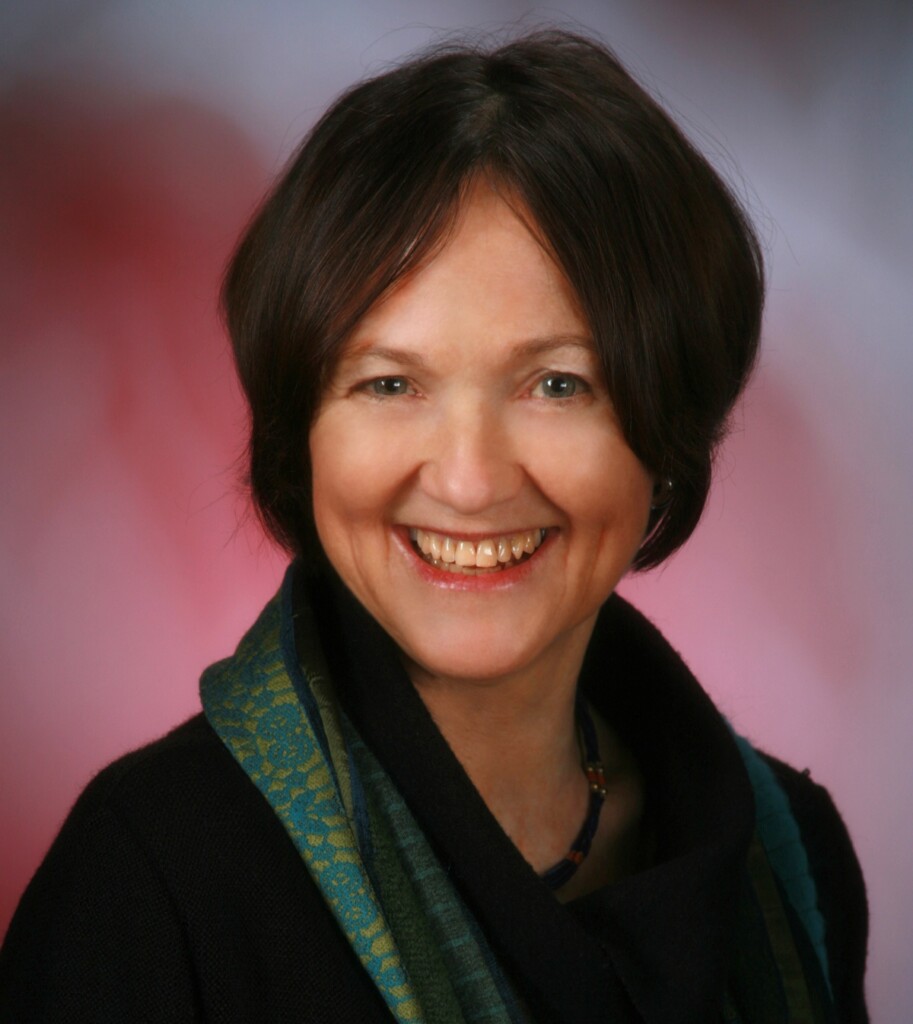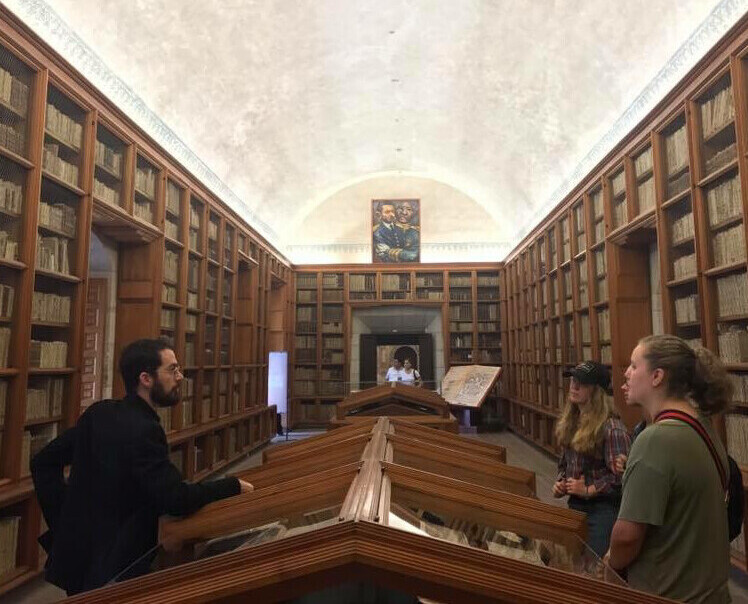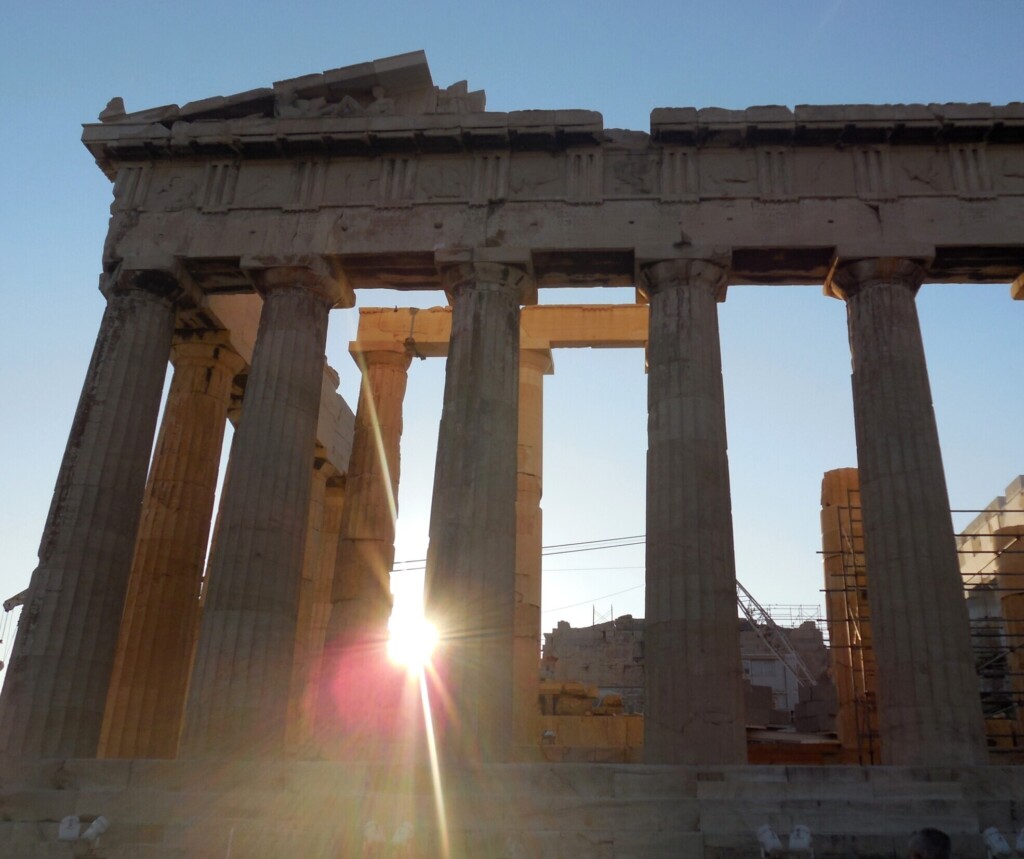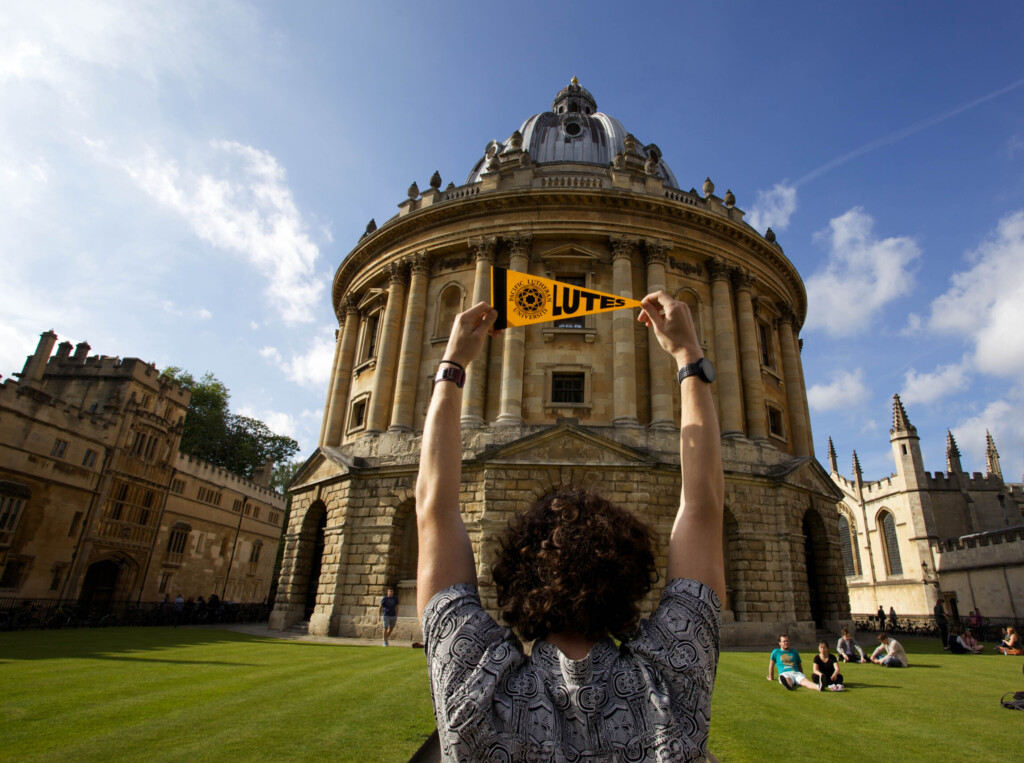The Pragmatism of the Liberal Arts
By Roberta Brown
Originally published in 1999
My lifelong commitment to the liberal arts took root in the fourth grade, when I met my classmate and dear life-long friend Sally. During that entire year, Sally rode her bike to my house, and after school, we both rode our bikes to hers. We read books on her neatly made bunk beds and I spent the night there as often as possible. In junior high, Sally lugged her books around in an old Harvard green bag that she slung over her slumped shoulders. She had glasses, braces, long hair pulled straight back. She wore heavy brown and white oxford with thin anklets, and her long hems were always crooked. Hanging around with Sally damaged my fragile popularity, but she was still my dearest friend. Today Sally is a world-class geneticist at an eminent university. During our rare encounters, we continue to share an uncanny unity of vision about education, and a resulting friendship.
A seemingly bland statement Sally made during our last dinner together clarified for me this shared vision. Our conversation with her economist husband had been tracing the jagged edges of the stock market when Sally suddenly bailed out. Changing the subject, she declared that whatever she’s worth in stock, her greatest wealth and that of her family was in their education.
At the time, I thought that was demurring to the lowly undergraduate teacher and humanist sitting across the table. But upon reflection, I recognize that Sally had been talking about liberal education, an American ritual that is part of the “great American experiment in civil democracy.”[1]. On further reflection, I recognize that it was her home life that had prepared Sally as a seventeen-year-old to turn down opportunities to attend prestigious universities with professional orientations in favor of a small liberal arts college. In turn, it was her resulting strong foundation in the liberal arts that now helps account for Sally’s remarkable success as a professional.
Sally’s parents were no more religious than mine, but there was a religious aura in her home. Faith in the existence of ultimate knowledge was reflected in their humble curiosity about everything from the wires behind the light switch to particles smaller than electrons. They always listened to and genuinely seemed to value my comments, no matter how mundane or half-baked they were. I felt welcomed and even wanted. Faith in the existence of ultimate meaning to life gave her parents a vantage from which they could pluck those activities that really mattered form the distracting chaos of everyday life. Faith in their neighbor engaged them in local politics and civic groups. And a sense of gratefulness for their modest, middle-class comforts freed them from enslavement to the already rising god of consumerism.

For me Sally’s home was nothing less than a temple of peace and inspiration. Like the best of teachers, her parents had perfected an environment that nurtured learning. Never lecturing, showing off their own knowledge, or being judgmental, they nevertheless continually questioned, then exemplified and shared, the excitement of discovering an answer. In this sense, they accomplished the most that any liberal arts professor can and should do, particularly in our Internet age when the sheer volume of factual information can seem to threaten human creativity and meaning. Interestingly, they both had graduated from a small liberal arts college in the Pacific Northwest.
Simple as it may appear, this story bears substantially upon a debate that is permeating all levels of education in the United States today. Embracing a culturally invasive consumerism, many students and their families have come to value their education only as much as the salary that their diplomas obtain. In response, administrators in many high schools and even in some private universities with strong liberal arts traditions are hoisting a banner of vocationalism. Here at PLU, there has also been a response. We have chosen to respond to this shift by claiming that our students can expect to receive both a strong professional and an excellent liberal arts preparation —in a mere four years. The question I wish to address here is whether, in our hastiness to please our consumers, we have overlooked some of the deeper questions and implications that arise from such an institutional claim.

It must be recognized in the first place that the ultimate burden of carrying out this unique response of PLU lies with the faculty. Thus, as a group of professionals, we must ask ourselves if we can in fact uphold such a claim in practice and with integrity. In other words, can we make it a reality in the praxis of our classrooms and programs? Although promoted in good faith and with the interest of the institution at heart, is the mixing of liberal arts and professional undergraduate education pragmatic or even possible? And though clearly honed in response to consumer demand, is it in fact serving the best interest of PLU, in terms of our endowment and identity, and for that matter, of the minds and careers of our students? And finally, does it uphold, in practice, the tenets of our mission statement? In particular, does it allow a student’s undergraduate education to provide “the necessary and essential foundation for the technical training and education in the professions which modern society requires” [my italics]?
To date, we have begun discussions about new programs in which courses offered by faculty in the professional schools would be combined with courses traditionally offered by faculty in the College of Arts and Sciences. Professors in the professional schools are also being drawn into foundational courses, such as the Freshman experience. Potential cross-disciplinary programs that result from such creative overlaps are the stuff that make for an exciting undergraduate education today. No matter what our claimed identity may be, it seems that we should be nourishing these bridges. My concern, though, is that inasmuch as such programs are based primarily upon administrative structural overlap, they skirt the issue that is at the heart of the national debate today about the significance and uniqueness of American education. That is to say, they do not address the knotty task of probing the ultimate ingredients that constitute and make pragmatically meaningful either professional or liberal arts education. In the remaining paragraphs, I would like to offer a few initial reflections as kindling for the dialogue that I believe to be vital to the integrity of our institution and to our identity. These bits of wood will undoubtedly reveal their sources, which is deeply rooted in the humanities.
My hunch is that understanding the foundations of liberal arts and professional orientations in the classroom calls us to reflect upon what many world religions and psychological theories define as two opposing—if equally necessary— orientations to life. For want of a better term, these orientations might be termed the cultivation of the me, and the cultivation of the I. The me is the role or persona that we all hone in order to be accepted by the conventional society of our cultures and in order, quite simply, to earn a living. The source of this identity is in the conventions of the group to which we choose to belong. It is an identity molded from without. If transposed to the educational front, one might construe professional education in a parallel fashion, as the imbuing of factual knowledge and skills requisite for a career within a particular professional group. In this sense, an English course that might be based upon learning and using the bibliographic guidelines of the Modern Language Association would have a professional orientation. And a language course designed primarily to prepare students for state-administered proficiency exams would also be professional, even though it is housed in a school typically identified with the liberal arts.
While religious and psychological traditions have long recognized the inevitable need for all humans to develop a me, which they equate with the ego or the self-conscious individual, they also tell us that the fully developed person grounds and even selects this me upon a previously honed I. In religious traditions, the I is the deeply founded spirit or soul that lies in all humans; it is the authentic self, the seat of grade, that touchstone without which we cannot experience the presence of a divine spirit. Such a grounding is what frees the human spirit from unreflective conformity and self-serving ends. In Lutheran terms, it opens the soul to the source of faith that inspires love of neighbor. It also responds to the true meaning of Lutheran vocationalism: it allows one to select a profession through a sense of authentic calling or knowledge of self, rather than a dreamed-of salary. In short, discovery of the authentic I inspires professional creativity, and compassionate, reflective citizenship.
Creating an environment that promotes lifelong honing of the I is what liberal education is all about. As such, the undergraduate “liberal arts” skills that students learn, be they history, biology, a foreign language, or psychology, should in praxis be a mere framework through which an attentive teacher lays a path for students to discover their own authenticity. As an institution that claims to provide a liberal arts foundation, and moreover, as one with connections to a religious faith, I believe that we are beholden to furnish this groundwork for human growth.
It is such an orientation that Professor Martha Nussbaum has addressed in a recent, widely recognized publication entitled Cultivating Humanity. Making an elegant argument for American undergraduate education to retain its primary commitment to the liberal arts, Nussbaum claims that higher education is facing “the risk of being undermined by a growing interest in vocational, rather than liberal education.” [2]
In order to alert institutions whose integrity is being undermined by the temptations of such a risk, she provides instructive examples of successful liberal arts programs throughout the country, and bases a bold new proposal for the liberal arts upon her observations. Because her discussion is so germane to our dialogue, I will outline a few of its main components and what I perceive to be their implications for PLU.

Nussbaum begins by dismissing an older definition of the liberal arts, which she describes as “an education that is liberalis, ‘fitted for freedom,’ in the sense that it is aimed at freeborn gentlemen of the propertied class.” This pre-Socratic education, she reminds us, “initiated the elite into the time-honored traditions of their own society; it sought continuity and fidelity, and discouraged critical reflection” (293). Turning to PLU, it is my perception that increasing numbers of students enter my classes seeking a comfortable confirmation of their views, traditions, and habits of thought rather than pursuing the uncomfortable challenge to those views, which is the sign of real intellectual exploration. Many of these same students claim to have selected professional paths even before arriving on campus and are thus less interested in courses whose primary purpose is not to equip them with the skills of their hastily chosen profession, but to cultivate their minds more deeply. It is often not until their junior or senior years, if ever, that they discover their authentic calling, in the sense that Luther understood, and as a result, they often being a new major late in their PLU careers.
What I fear is a new population of PLU students that does not recognize how a strong liberal arts foundation can provide the self-knowledge —the personal I— necessary for recognition of authentic vocation. And such a foundation—which may not result from a sparse scattering of courses in a freshman year program, however excellent— is the only practical solution to what I’d call such “premature professionalism.” In short, I sense that we are not yet discussing the fact that our newly claimed orientation may attract a population of students unprepared for and ill-disposed toward liberal education. There is only a limited population of students in the Pacific Northwest. With schools such as Willamette and Lewis and Clark explicitly identifying their undergraduate curriculum with the liberal arts, students seeking such an education may not select PLU. And as a result, PLU may inadvertently become a stronghold for elitist liberalism.
To avoid such a risk, which could have ultimately financial as well as academic consequences for the institution, it is imperative that we examine Nussbaum’s definition of the new liberal arts paradigm. Such an education, she states, “produces students who are free not because of wealth or birth, but because they have a mind of their own . . . they have ownership of their own thought and speech, and this imparts to them a dignity that is far beyond the outer dignity of class and rank” (293). Such ownership of one’s mind is related to my earlier suggestion of cultivating the subjective I. A first step toward ownership, she states, is learning to think critically. Contrary to some today who fear it, she insists that critical thought does not mean that students will deny their heritage. Instead, it is only after rational examination and upon awareness of viable alternatives that they can in fact call a tradition their own. She assures us that through such a critical approach, students are not lost in a morass of postmodernist cultural relativism, nor are they circumscribed by doctrinal belief. Instead they have the intellectual foundation and sense of self that is a first step to becoming citizens of an increasingly complex, post-nationalist globe.
Such citizenship also requires, however, that the student develop what Nussbaum calls a narrative imagination, that jump of faith that allows one to engage empathetically and without fear in a heritage or idea that is not one’s own. “Our country has embarked on an unparalleled experiment, inspired by these ideals of self-command and cultivating humanity. Unlike all other nations, we ask a higher education to contribute a general preparation for citizenship, not just a specialized preparation for a career . . . People who have never learned to use reason and imagination to enter a broader world of cultures, groups, and ideas are impoverished personally and politically, however successful their vocational preparation” (294, 297). Through detailed descriptions of her research on undergraduate programs, Nussbaum demonstrates that this imagination—not unlike the compassion and love of neighbor that accompanies the I—cannot be developed through an unstructured, distributive core with a sprinkling of “liberal arts” courses and a single diversity or cross-cultural requirement, such as we presently have at PLU. Instead, she argues that it is meticulously designed liberal arts core programs with cross-cultural and global bases that attain this goal most successfully.

In her book, Nussbaum suggests to us at PLU that our journey toward preparing students for living lives of world citizenship has only begun. Until we require a substantial body of courses that will orient students to discovering and voicing with integrity their authentic beliefs and callings, to developing a sense of empathy for and understanding of those cultures that do not share their views, I am not sure if we can claim to uphold our mission statement. My hope is that the perceived market pressures will not frighten us off course before we have even completed the first lap toward this very pragmatic goal. Our experiment with the New American College has been both bold and fascinating, but it is my sense that, at the deeper pedagogical level, it simply does not work. Ultimately what really counts is that we never cease to attract and enjoy the privilege of educating reflecting and spirited students—students like my friend Sally— who are eager to cultivate their own souls in preparation for eventual devotion to a profession and to the world.
NOTES
1 – Neil Postman, in The End of Education (1995) argues that American schools should “provide our youth with the knowledge and will to participate in the great experiment; to teach them how to argue, and to help them discover what questions are worth arguing about; and, of course, to make sure they know what happens when arguments cease” (73-4). He also suggests that education aim for the student “to become a different person because of something you have learned —to appropriate an insight, a concept, a vision, so that your world is altered” (3).
2 – Martha Nussbaum, Cultivating Humanity: A Classical Defense of Reform in Liberal Education (1997), 297


